-

This weekend we would have been presenting our Green and Pleasant Land show curated as part of this year’s Dulwich Festival. The show was to feature ceramics, paintings and sculpture looking at how our artists interpret rural and urban landscapes through their own narrative and cultural references. Over the next few weeks, we’ll focus on some of those artists that we had planned to feature in the exhibition in these weekly posts. This week we talk to the very talented, South London painter Rebecca McLynn, whose work has been a feature of our Dulwich Festival shows for a number of years.
While largely abstract, the source of inspiration for Rebecca’s paintings is deeply rooted in the landscape and this is evident from the first time you encounter Rebecca’s work. As one of our clients’ so eloquently describes:
“I was immediately drawn to Rebecca’s painting. The beauty, intensity and remoteness of the seascape and the richness of colour and texture evoke the drama and ever-changing mood of the wild Atlantic shoreline, reminding me of happy summer days in Ireland. I find her work mesmerising – consoling when moments of calm contemplation are needed and, at all times, a beguiling backdrop and abiding reminder of the beauty of nature.”
Caroline Carberry QC
We caught up with Rebecca this week to find out more about her work and the inspiration behind it.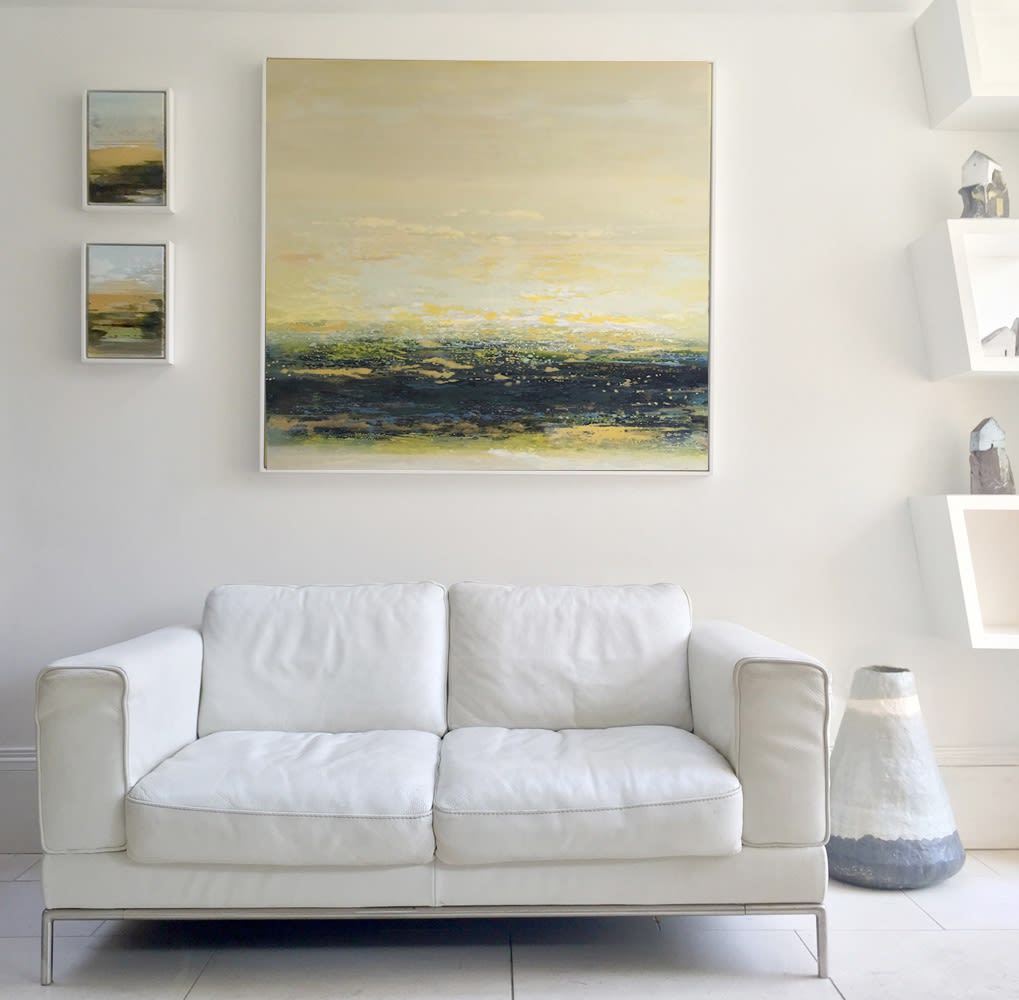
Rebecca McLynn: Focal painting, Brae 2, 104 x 123 cm, oil on canvas
Shown here with smaller works by Rebecca (both sold), also featured in the image are Houses on Rocks by Rowena Brown and large hand-built pot by Daniel ReynoldsCF: Where did you study Rebecca and at what moment did you realise the journey you were going to take and the way in which you would paint?
RML: I always wanted to be an artist. I never wavered from that but I was impatient to get away to university and become a student or I would have done a Foundation year and then gone on to art school. Instead, I went away to study at Lancaster University and did a BA (hons) in Visual Art and Philosophical Aesthetics, followed by a PGCE in London to teach art and it wasn’t until after my children were born that I went back to Wimbledon School of Art and did a Masters in Fine Art and that was my true calling.
Interestingly, when I was doing my degree I was more concerned with painting figures, almost in a Matisse like way. Landscape painting did nothing for me, I saw it as dated and dull and I was not interested in it at all, despite having grown up in rural Derbyshire and being surrounded by the most beautiful landscape in Lancaster. This changed when I came to London, I guess being in an urban environment made me nostalgic for the landscapes of my childhood. I became increasingly pulled towards the romance of the Derbyshire and Northern countryside but it wasn’t until I visited Ireland for the first time that everything came together. I was so visually inspired there that I was almost compelled to make work in response to this landscape. Everything about that place from the light, to the detail of the rocks, the sea, the inland, the smell of the turf, the ancient woodland, its history, I was spellbound. It reminded me so much of what I loved about the north of England and particularly of Derbyshire when I was growing up. Ireland continues to inspire me and I’ve spent a lot of time there over the years, on the remoter islands and in the west of Ireland where the coast is particularly wild.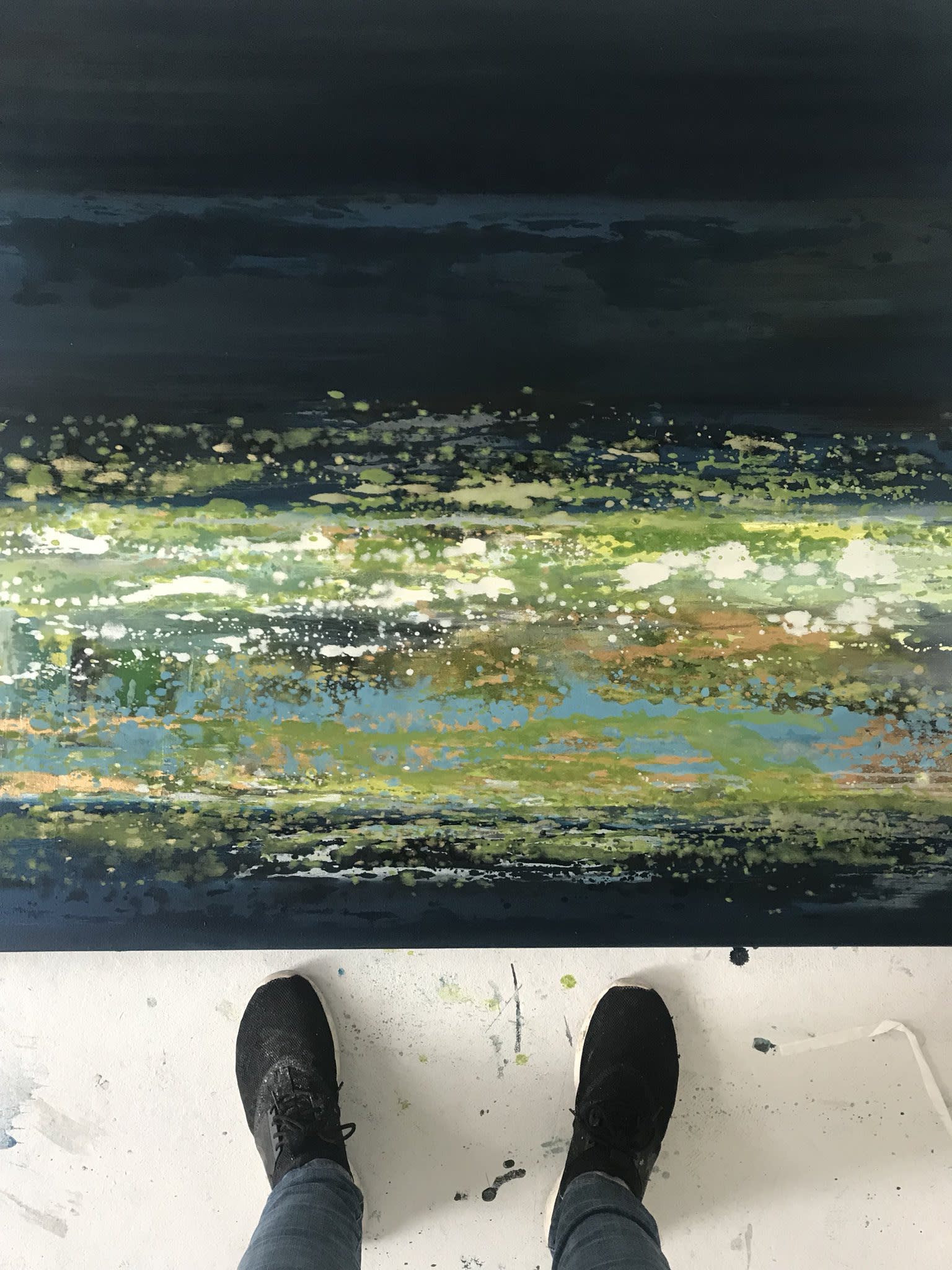
Rebecca McLynn: Night Valley 2, 98 x 103 cm, oil on canvas
CF: We have seen you working from above like Pollock, pouring the paint, can you expand a bit on your process and technique?
RML: I try to emulate the experience of a place, something more than figuration, I want to capture the essence of the landscape, the atmosphere, the weather conditions, fog, rain, coldness, texture and so on. So I try to echo those qualities with paint and materials in my work. This could be by using wax and lustres to mimic ice or rock, linseed oil thin washes for damp grass or veils of mist and rain and in doing so, I try to capture that raw element of place, I want to offer something additional to the traditional image of painted landscapes. I use photography a lot as triggers for my work and I do work flat mostly and I pour, drag and move the canvas. I don’t ever work upright until the very end when I’m adding the final touches to each painting.
Rebecca McLynn: Night Tide, 103 x 113 cm, oil on canvas
Shown here with Yellow pod by Sophie Cook, blue and white vessels by Rhian Malin and Jessica Thorn and large yellow hand-built pot by Daniel Reynolds.CF: The light you achieve is quite unique and we love how the work glows as the light changes. What pigments are you combining to achieve this amazing glow which brings nature to life?
RML: My favourite shop is Cornellisons up near the British Museum in London and I find it hard to go in there without buying anything. I buy pearl lustres and raw pigment, linseed and poppy oil, waxes, ready-made paints and I buy titanium white, indigo, terre vert and sepia amongst others.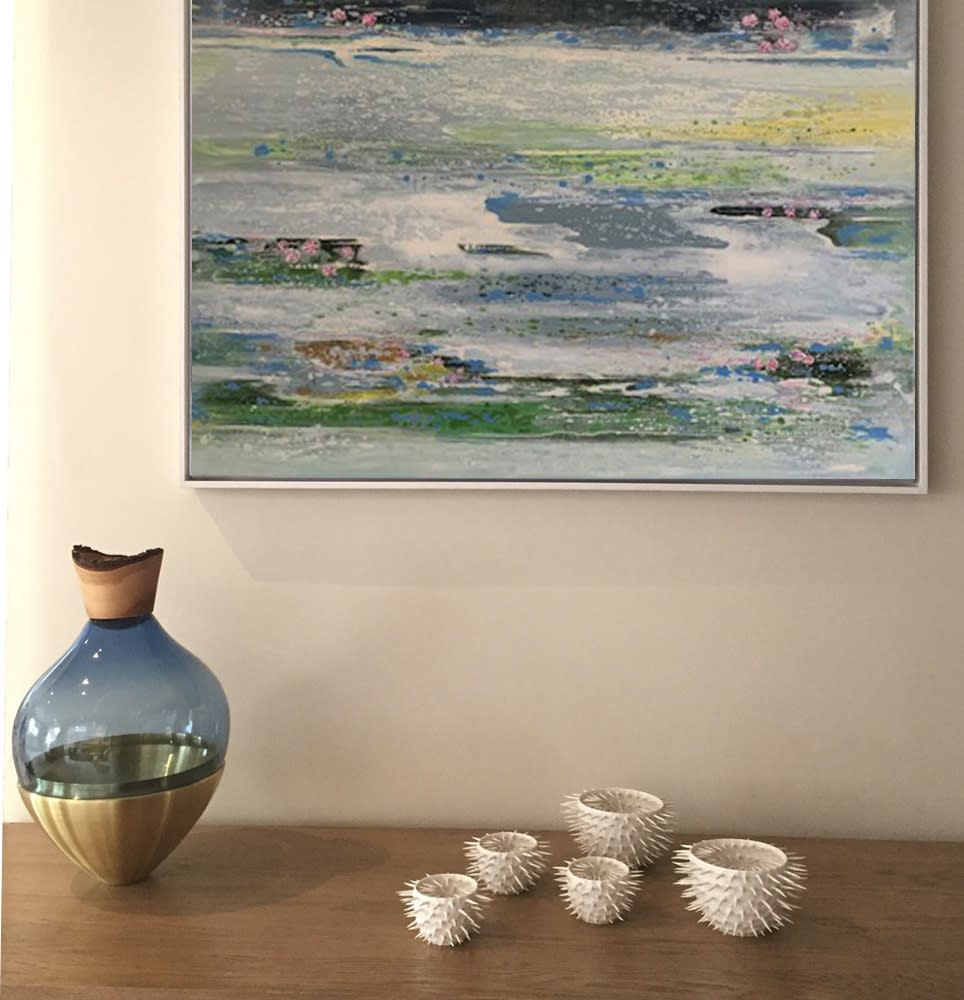
Rebecca McLynn: Cliff Treasure, 93 x 93 cm, oil on canvas
Shown alongside: India Vessel by Pia Wustenberg and Spiky bowls by Ikuko IwamotoCF: Colour is important to your work. Do you work in series according to the Seasons or do you work on various paintings at once?
RML: Yes I am seasonally affected. I work on several paintings at a time, in groups of themes, never just one painting on its own. I might work on a set of sea pieces in parallel to a set of work on inland woodlands. I collect groups of resources, colour, texture, they may be from a selection of different places and I’ll collate them into different categories. I’ll have photographs that I’ve taken, drawings and sketches I’ve done, featuring details of water, inland water, seawater, rock, foliage from woodlands, close up details of plants, images of mountain areas, even just photographs of weather, snow, rain and ice. That way if am working on a particular theme or painting, I’ll have several references from different places to remind me of the places that I’m drawn to. So one painting may be triggered by the emotional response I’ve experienced from a number of places, be they Ireland, Derbyshire, Scotland or the Atlantic Coast.CF: Yes, that’s so true, and it’s certainly what we find resonates with those clients who have bought your work, Rebecca. Clients are reminded of their own emotional responses to particular landscapes in their lives, past or present. It’s a really strong pull for them.
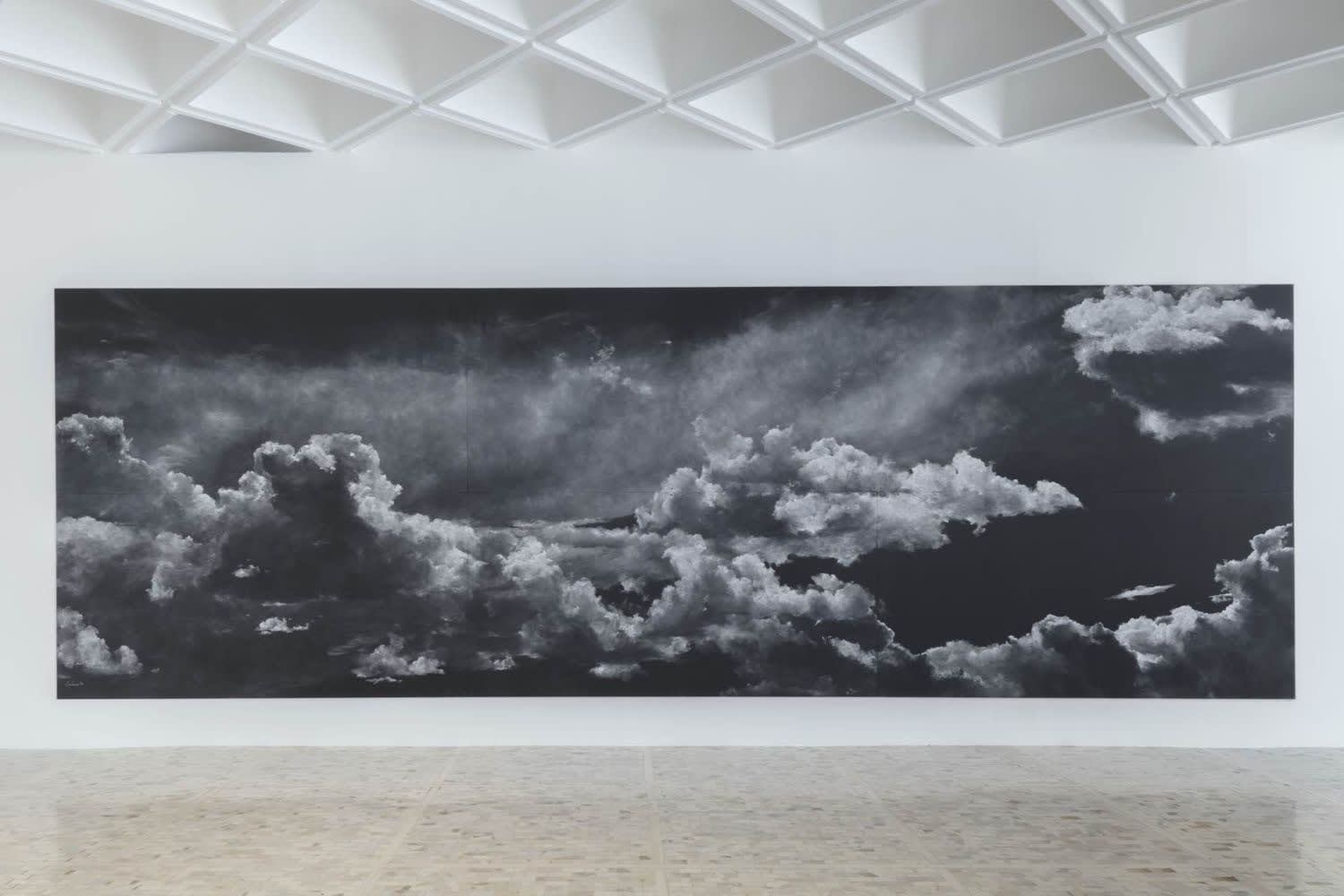
Tacita Dean, Cúmulo, 2016. Installation view Museo Tamayo, Mexico City, Photo: Agustin Garza.Courtesy of Tacita Dean, Frith Street Gallery, London and Marian Goodman Gallery, New York/Paris/London.
CF: Are there any artists that inspire you and your work?
RML: There are several artists that I’m always inspired by, like Hughie O’Donoghue, Ian McKeever, Albert Pinkham Ryder, Tacita Dean and Thomas Joshua Cooper.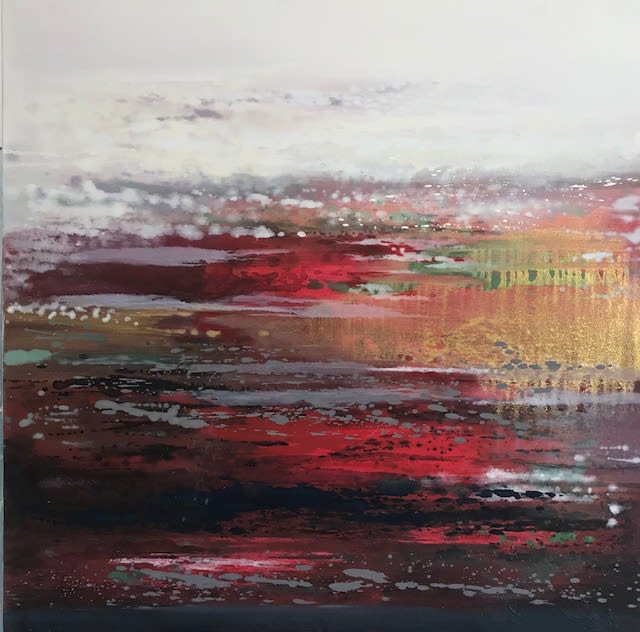
Rebecca McLynn: Meadow, 80 x 80 cm, oil on canvas
CF: Your paintings feel very poetic, does poetry inspire you and if so do you have a favourite?
RML: I do love poetry and I’m often read poetry alongside working and sometimes the titles of my works are inspired by poetry. I am a fan of poems by Gerard Manley Hopkins, Emily Bronte, Sylvia Plath, Dylan Thomas, Mary O’Malley, Pierce Hutchinson, Seamus Heaney and WB Yeats, in particular. Holy Spring by Dylan Thomas is a favourite of mine.
CF: During lockdown, we are all noticing nature’s subtle but constant changes in a way that many of us haven’t done before. As someone who is inspired by the landscape, how has self-isolation influenced your work?
RML: I thought I would make a lot of work as painting is a solitary experience anyway but it hasn’t been like that. I’ve actually found I’ve spent more time thinking and walking, taking photographs and listening and regarding nature in more detail, I’ve done quite a lot of drawing too. Everything has slowed down, the birds are louder, the hot weather has bought out the spring flowers in abundance and where I am staying has been more pastoral pretty than wild and dramatic, but the peace and comfort of nature has been lovely. It has made me crave wild real nature more.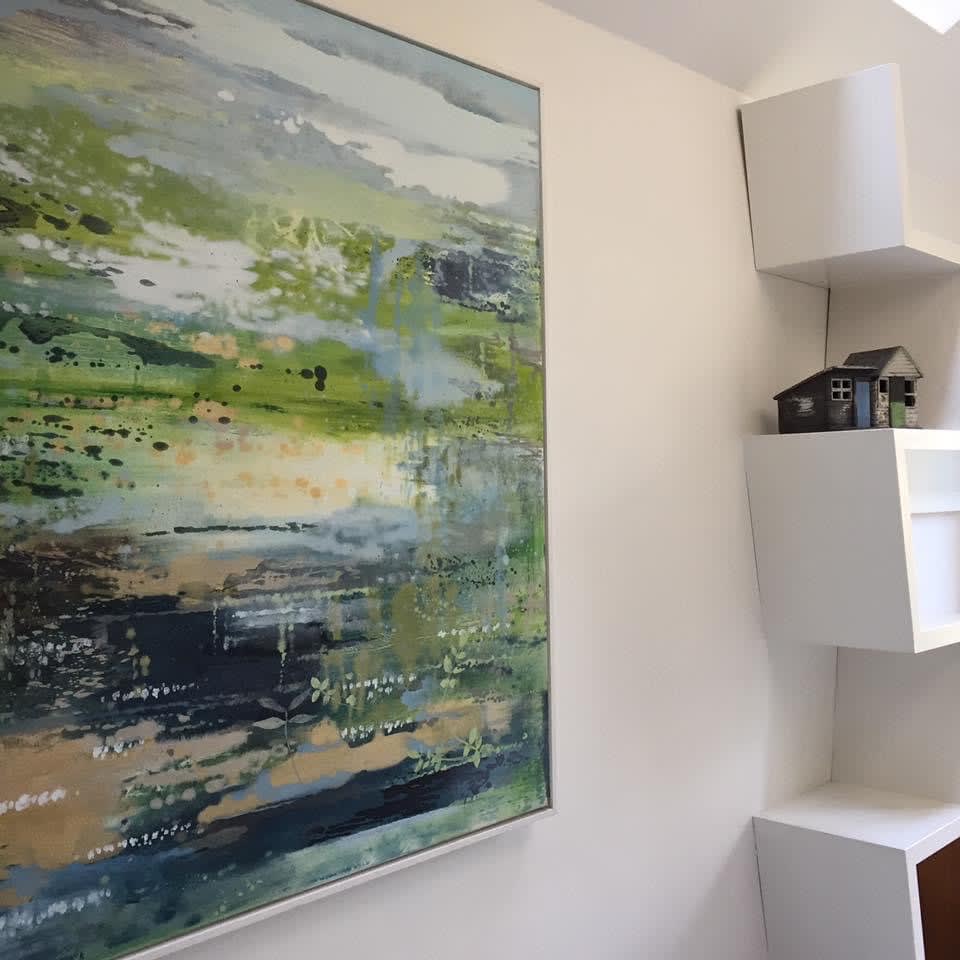
Rebecca McLynn: Woodland, 103 x 113 cm, oil on canvas
CF: What plans do you have for the future Rebecca?
RML: I plan to keep striving to get better at capturing that essence. To achieve the synthesis of my photographic work and paint. I am always trying to find a place where the image trigger I capture in my photos meets the expressive side of painting. It’s an ongoing journey for me.
CF: Thanks for talking with us today Rebecca.See more work by Rebecca McLynn